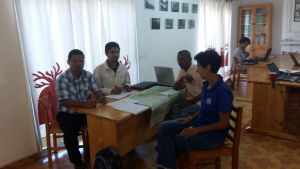In the Duke Lemur Center’s new “Notes from the Field” series, we follow DLC researcher and SAVA Conservation Project Coordinator Marina Blanco on a field expedition to Madagascar. This is the first entry in our multi-part series.

The research team discusses sites and logistics at Vahatra office in Tana. From left to right: Christian (herps), Toky (small mammals), Mihaja (birds) and Marina (lemurs).
From Marina: An Introduction
As a Duke Lemur Center research postdoc, I had several opportunities to participate in field expeditions with colleagues from the U.S. as well as Malagasy students. My focus had been primarily behavioral ecology of mouse and dwarf lemurs (for example, here) and I had, generally, interacted more with wild animals than with people. This year, however, I joined the DLC/SAVA Conservation team as their Project Coordinator and my personal and career goals expanded considerably. This was the opportunity I’d been hoping for to combine my research and conservation goals: to try to achieve a balance between realistic endeavors and idealistic goals; conducting basic research and getting to know people; and acquiring biological knowledge while seeking anthropological understanding.
Destination: The COMATSA Corridor
One of our next projects reflects, in essence, the spirit of DLC/SAVA Conservation because it integrates research, capacity building, and conservation efforts. Anne Yoder (DLC Director) and Charlie Welch (DLC Conservation Coordinator) were recently awarded a grant from Conservation, Food, and Health Foundation (CFHF) to conduct “corridor science” in northern Madagascar. The COMATSA corridor, our destination, is comprised of more than 300,000 hectares and is the second largest terrestrial protected area in Madagascar. This impressively large corridor, currently managed by World Wildlife Fund (WWF), connects Marojejy National Park to the east, Anjanaharibe Sud to the west, and Tsaratanana to the north. Due to the large geographic coverage, the corridor connects areas harboring different animal and plant species; for example, the indri – the largest living lemur – is found in Anjanaharibe Sud but is absent in Marojejy. We still know too little about species distributions, potential barriers for dispersal, and fragmentation within the corridor.
Studying this area is as fascinating as it is challenging. Large portions of the forest are remote and hard to reach and thus remain unsurveyed. Moreover, thousands of people make a livelihood in this region. The longterm success of forest protection will depend on institutional efforts (e.g., Madagascar National Parks and WWF) as well as the active participation of local communities in managing water and resources, practicing sustainable agriculture, and engaging in alternative practices for research use and extraction. Connecting people to wildlife, connecting needs and availability, and traditional as well as scientific knowledge are essential for the ultimate goal of protecting biodiversity.
Goals of the Expedition
For the purpose of the grant, our team will be conducting biological surveys in two selected sites within COMATSA, in areas that had been sampled nearly 15 years ago by Steve Goodman and his team. The primary goals of the project will be:
1. Report on the biodiversity of main animal groups (herps, birds, micro-mammals, and lemurs) at each site, and compare them to prior assessments.
2. Collect biological samples that will help address the question of biological diversity and genetic flow between forest sites.
3. Document travel and disturbance at each site to roughly characterize habitat status.
4. Facilitate Malagasy student training and integration.
5. Discuss possible reforestation strategies with WWF that could increase corridor connectivity or assist with buffer zones to protect forest boundaries.
Conclusion and Future
As we are organizing the expedition, getting materials ready, updating food lists, and getting documents approved, I am looking forward to actually setting up camp and sharing the experiences of our daily routines at the end of each day: telling stories about uncommon species, rejoicing in the sense of discovery that accompanies expeditions like this, and talking about life around the campfire with bellies full of rice and beans. If we are lucky enough to find areas with phone reception, I will be updating DLC staff about our activities, findings, and news as we navigate the forest. If we encounter challenges along the way, those will be described as well – for it is usually under unexpected circumstances that people bond and come together.
If you want to follow us on Google earth, we will be around 14° 32’ 18.00” S, 49° 26’ 18.00” E.
—Marina
For the next installment, click here for Birds, Micromammals, & Herps.

